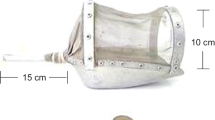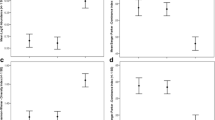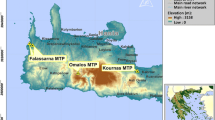Abstract
Recent and increasing interest in temporary ponds as biodiversity reservoirs fosters our need to test sampling techniques for characterising their biological communities. We compared the efficiency of dip-netting to that of fyke nets in sampling the macroinvertebrate assemblage of a temporary pond in Doñana National Park (SW Spain). We sampled the pond at four different times—morning, afternoon, evening and night—distinguishing between deep and shallow zones. In our sampling, dip-netting captured a higher number of taxa, and higher abundances of individuals than fyke nets. However, both techniques captured exclusive taxa, not recorded with the other device. Fyke nets distinguished between nocturnal and diurnal macroinvertebrates, and hence are more appropriate to study macroinvertebrate diel activity. We detected nocturnal activity in Gerris thoracicus larvae, and adults of Colymbetes fuscus, Rhantus suturalis, Rhantus hispanicus and Hydrochara flavipes. Conversely, larvae of Sympetrum fonscolombei and Notonecta spp., and adults of Notonecta glauca were mainly diurnal. The overall diel activity pattern of the macroinvertebrate assemblage depended on the diel activities of their integrating taxa and stages. Although dip-netting was more appropriate to sample macroinvertebrate assemblages in different microhabitats, fyke nets better captured nocturnal and fast-swimming invertebrates. Consequently, the joint use of both sampling techniques would capture a better picture of the representative macrofauna of a temporary pond than either one on its own.



Similar content being viewed by others
References
Becerra Jurado, G., M. Masterson, R. Harrington & M. Kelly-Quinn, 2008. Evaluation of sampling methods for macroinvertebrate biodiversity estimation in heavily vegetated ponds. Hydrobiologia 597: 97–107.
Biggs, J., P. Williams, M. Whitfield, P. Nicolet & A. Weatherby, 2005. 15 Years of pond assessment in Britain: results and lessons learned from the work of pond conservation. Aquatic Conservation: Marine and Freshwater Ecosystems 15: 693–714.
Bilton, D. T., L. McAbendroth, A. Bedford & P. M. Ramsay, 2006. How wide to cast the net? Cross-taxon congruence of species richness, community similarity and indicator taxa in ponds. Freshwater Biology 51: 578–590.
Bilton, D. T., L. McAbendroth, P. Nicolet, A. Bedford, S. D. Rundle, A. Foggo & P. M. Ramsay, 2009. Ecology and conservation status of temporary and fluctuating ponds in two areas of Southern England. Aquatic Conservation: Marine and Freshwater Ecosystems 19: 134–146.
Brinkman, M. A. & W. G. Duffy, 1996. Evaluation of four wetland aquatic invertebrate samplers and four sample sorting methods. Journal of Freshwater Ecology 11: 193–200.
Brittain, J. E. & T. J. Eikeland, 1988. Invertebrate drift – a review. Hydrobiologia 166: 77–93.
Cellot, B., 1989. Macroinvertebrate movements in a large European river. Freshwater Biology 22: 45–55.
Céréghino, R. & P. Lavandier, 1998. Influence of hydropeaking on the distribution and larval development of the Plecoptera from a mountain stream. Regulated Rivers: Research and Management 14: 297–309.
Céréghino, R., J. Biggs, B. Oertli & S. Declerck, 2008. The ecology of European ponds: defining the characteristics of a neglected freshwater habitat. Hydrobiologia 597: 1–6.
Cheal, F., J. A. Davis, J. E. Growns, J. S. Bradley & F. H. Whittles, 1993. The influence of sampling method on the classification of wetland macroinvertebrate communities. Hydrobiologia 257: 47–56.
Clarke, K. R. & R. M. Warwick, 2001. Change in Marine Communities: An Approach to Statistical Analysis and Interpretation, 2nd ed. PRIMER-E, Plymouth.
Collinson, N. H., J. Biggs, A. Corfield, M. J. Hodson, D. Walker, M. Whitfield & P. J. Williams, 1995. Temporary and permanent ponds: an assessment of the effects of drying out on the conservation value of aquatic macroinvertebrate communities. Biological Conservation 74: 125–133.
Díaz-Paniagua, C., R. Fernández-Zamudio, M. Florencio, P. García-Murillo, C. Gómez-Rodriguez, P. Siljestrom & L. Serrano, 2010. Temporary ponds from the Doñana National Park: a system of natural habitats for the preservation of aquatic flora and fauna. Limnetica 29: 1–18.
Dolmen, D. & J. O. Solem, 2002. Locomotor activity patterns in Ilybius fenestratus (Fabricius) (Coleoptera, Dytiscidae) in a Central Norwegian Lake, with evidence of breeding-induced arrhythmicity. Aquatic Insects 24: 207–211.
Elliott, J. M., 2002. A quantitative study of day–night changes in the spatial distribution of insects in a stony stream. Journal of Animal Ecology 71: 112–122.
Elliott, J. M., 2005. Day–night changes in the spatial distribution and habitat preferences of freshwater shrimps, Gammarus pulex, in a stony stream. Freshwater Biology 50: 552–566.
Espinar, J. & L. Serrano, 2009. A quantitative hydrogeomorphic approach to the classification of temporary wetlands in the Doñana National Park (SW Spain). Aquatic Ecology 43: 323–334.
Florencio, M., L. Serrano, C. Gómez-Rodríguez, A. Millán & C. Díaz-Paniagua, 2009. Inter and intra-annual variations of macroinvertebrate assemblages are related to the hydroperiod in Mediterranean temporary ponds. Hydrobiologia 634: 167–183.
García-Criado, F. & C. Trigal, 2005. Comparison of several techniques for sampling macroinvertebrates in different habitats of a North Iberian pond. Hydrobiologia 545: 103–115.
Gilbert, J. J. & S. E. Hampton, 2001. Diel vertical migrations of zooplankton in a shallow, fishless pond: a possible avoidance-response cascade induced by notonectids. Freshwater Biology 46: 611–621.
Gómez-Rodríguez, C., C. Díaz-Paniagua, L. Serrano, M. Florencio & A. Portheault, 2009. Mediterranean temporary ponds as amphibian breeding habitats: the importance of preserving pond network. Aquatic Ecology 43: 1179–1191.
Grillas, P., P. Gauthier, N. Yavercovski & P. Perennou, 2004. Mediterranean Temporary Pools; Volume 1 – Issues Relating to Conservation Functioning and Management. Station Biologique de la Tour du Valat, Arles.
Hamptom, S. E. & I. C. Duggan, 2003. Diel habitat shifts of macrofauna in a fishless pond. Marine and Freshwater Research 54: 797–805.
Hansen, E. A. & G. P. Closs, 2007. Temporal consistency in the long-term spatial distribution of macroinvertebrate drift along a stream reach. Hydrobiologia 575: 361–371.
Hanson, M. A., C. R. Roy, N. H. Euliss Jr, K. D. Zimmer & M. R. Riggs, 2000. A surface-associated activity trap for capturing water-surface and aquatic invertebrates in wetlands. Wetlands 20: 205–212.
Holomuzki, J. R., 1985. Life-history aspect of the predaceous diving beetle Dytiscus dauricus (Gebler), in Arizona. Southwestern Naturalist 30: 485–490.
Hyvönen, T. & P. Nummi, 2000. Activity traps and corer: complementary methods for sampling aquatic invertebrates. Hydrobiologia 432: 121–125.
Johnson, S. L. & A. P. Covich, 2000. The importance of night-time observations for determining habitat preferences of stream biota. Regulated Rivers: Research and Management 16: 91–99.
Legendre, P. & L. Legendre, 1998. Numerical Ecology: Developments in Environmental Modelling 20, 2nd ed. Elsevier Science Ltd., New York.
Maciolek, J. A., 1989. Tundra ponds of the Yukon Delta, Alaska, and their macroinvertebrate communities. Hydrobiologia 172: 193–206.
Marklund, O., I. Blindow & A. Hargeby, 2001. Distribution and diel migration of macroinvertebrates within dense funnel vegetation. Freshwater Biology 46: 913–924.
Murkin, H. R., P. G. Abbott & J. A. Kadlec, 1983. A comparison of activity traps and sweet nets for sampling nektonic invertebrates in wetlands. Freshwater Invertebrate Biology 2: 99–106.
Muzaffar, S. B. & M. H. Colbo, 2002. The effects of sampling technique on the ecological characterization of shallow, benthic macroinvertebrate communities in two Newfoundland ponds. Hydrobiologia 477: 31–39.
Nicolet, P., J. Biggs, G. Fox, M. J. Hodson, C. Reynolds, M. Whitfield & P. Williams, 2004. The wetland plant and macroinvertebrate assemblages of temporary ponds in England and Wales. Biological Conservation 120: 261–278.
O’Connor, A., S. Bradish, T. Reed, J. Moran, E. Regan, M. Visser, M. Gormally & M. S. Skeffington, 2004. A comparison of the efficacy of pond-net and box sampling methods in turloughs – Irish ephemeral aquatic systems. Hydrobiologia 524: 133–144.
Rincón, P. A. & J. Lobón-Cerviá, 1997. Temporal patterns in macroinvertebrate drift in a northern Spanish stream. Marine and Freshwater Research 48: 455–464.
Sokal, R. R. & F. J. Rohlf, 1997. Biometry. The Principles and Practice of Statistics in Biological Research, 3rd ed. W. H. Freeman and Company, New York.
Turner, A. M. & J. C. Trexler, 1997. Sampling aquatic invertebrates from marshes: evaluating the options. Journal of the North American Benthological Society 16: 694–709.
Urban, M. C., 2004. Disturbance heterogeneity determines freshwater metacommunity structure. Ecology 85: 2971–2978.
Waters, T. F., 1962. Diurnal periodicity in the drift of stream invertebrates. Ecology 43: 316–320.
Zacharias, I., E. Dimitrou, A. Dekker & E. Dorsman, 2007. Overview of temporary ponds in the Mediterranean region: threats, management and conservation issues. Journal of Environmental Biology 28: 1–9.
Acknowledgments
We are grateful to Azahara Gómez Flores and Lucien Briand for assistance in fieldwork. We are grateful to Andrés Millán for helping in the identification of taxa and to Isidro Román (Doñana Monitoring Team. Equipo de Seguimiento de Procesos Naturales-CSIC) for providing the photograph of a fyke net. We wish to thank the Spanish Ministry of Science and Innovation and European Union Feder Funds (CGL2006-04458/BOS and Fellowship grant CSIC-I3P to M.F.) and Junta de Andalucía (Excellence Research Project 932). The fellowship grant to Margarita Florencio was funded by European Union Social Fund.
Author information
Authors and Affiliations
Corresponding author
Additional information
Guest editors: D. Boix, B. Oertli, R. Céréghino, T. Kalettka, J. Biggs & A. P. Hull / Pond Research and Management in Europe – Proceedings of the 4th conference of the European Pond Conservation Network (Berlin 2010)
Electronic supplementary material
Below is the link to the electronic supplementary material.
Rights and permissions
About this article
Cite this article
Florencio, M., Díaz-Paniagua, C., Gomez-Mestre, I. et al. Sampling macroinvertebrates in a temporary pond: comparing the suitability of two techniques to detect richness, spatial segregation and diel activity. Hydrobiologia 689, 121–130 (2012). https://doi.org/10.1007/s10750-011-0690-8
Received:
Accepted:
Published:
Issue Date:
DOI: https://doi.org/10.1007/s10750-011-0690-8




